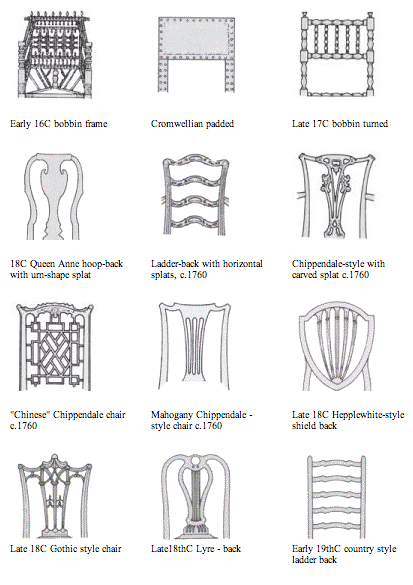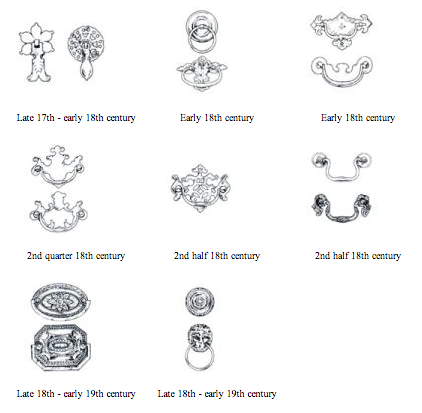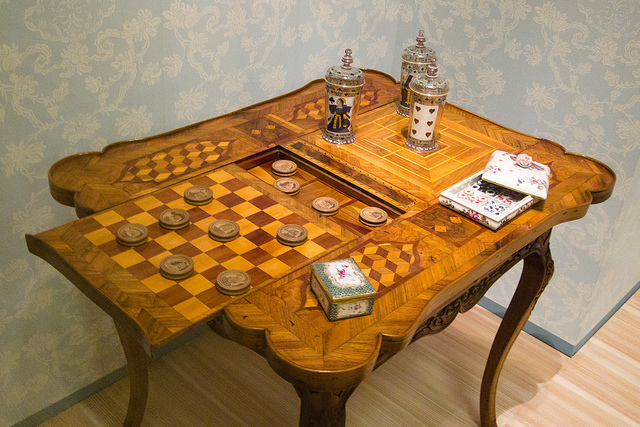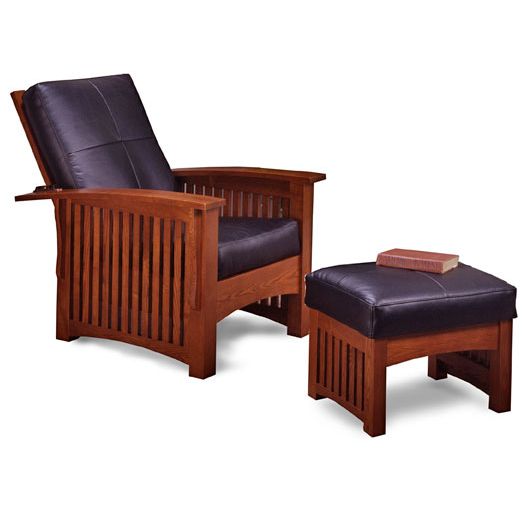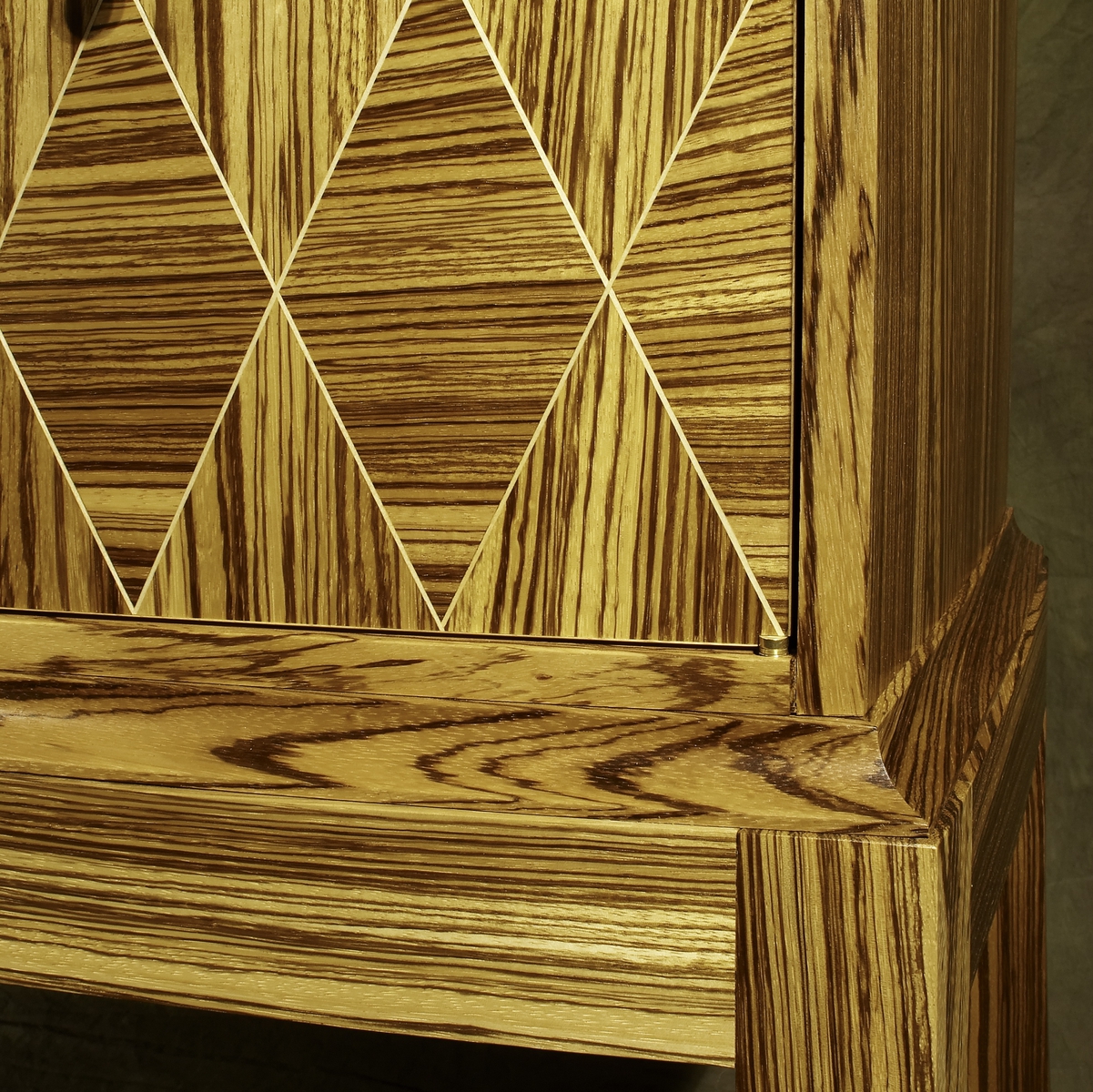This section discusses some of the most common types of furniture you’ll come across, and gives you hints about what to look out for if you’re thinking of investing in some antique pieces.
Of all the categories of antique you can collect, furniture is among the most popular and practical. Many pieces offer you the alternative of using them either for their original purpose, or of adapting them to modern-day living.
Furniture differs from other types of antique in that you probably don’t want to collect it by the type of object – nobody wants a room full of only chests or tables – but you may have an affinity for a particular wood or style of decoration. Whatever your preference, you need to familiarise yourself with the styles, methods of construction and types of material used, in order to determine whether the piece is ‘right’ (in other words, in its original condition without any major alterations or additions) or ‘wrong’ (some major change has been made to it, or it’s a fake).
Don’t be afraid to pull out drawers
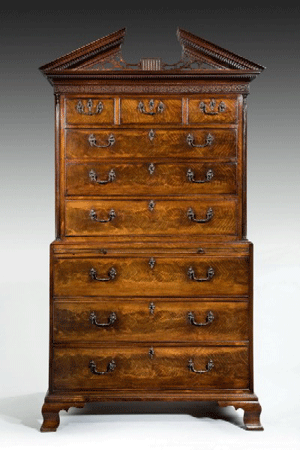 Once you’ve familiarised yourself with the basics, visit as many auctions and dealers as possible before you begin to buy. Don’t be afraid to pull out drawers, get down on the floor and look under table legs, and lift up chairs to look at their legs. Remember there’s no better way of learning about the subject than by hands-on experience!
Once you’ve familiarised yourself with the basics, visit as many auctions and dealers as possible before you begin to buy. Don’t be afraid to pull out drawers, get down on the floor and look under table legs, and lift up chairs to look at their legs. Remember there’s no better way of learning about the subject than by hands-on experience!
Quick Overview
The end of the 17th century saw the introduction of walnut furniture which has the advantage of being able to fit into the oak beamed cottage and the fine period home, together with more modern homes. There are some marvellous examples of cupboards, chest of drawers, tables, etc on the market today, with colour and size being the main points in determining value.
The mid 18th century saw the introduction of mahogany into the country, which coincided with the disappearence of walnut which had been extensively used as a timber for furniture in this country and Europe, especially in the Netherlands. Also,the introduction of design books by some of the finest makers, including Chippendale, Sheraton, Hepplewhite, etc, enabling everyone in the country access to the finest designs.
The Regency period saw a more flamboyant style being introduced alongside the traditional elegant Georgian style and these two ran side by side for a number of years.
By the mid 19th century the Victorian style had become well established with a much heavier look combined with a period of mass production which sometimes resulted in a reduction of quality, although there are exceptions to this.
The end of the 19th century and into the begining of the early 20th century saw a revival of the early elegant style of furniture making, using many of the Sheraton designs from the 18th century.
The Edwardian period is probably the last in which some of the highest quality pieces were made.
Woods
At first furniture was made from solid wood, but as cabinet-making improved, the technique of decorating furniture by applying veneers (thin sheets of wood) developed. This was an economical way of using expensive woods, and allowed the maker to create decorative effects from the different grains and patterns (called figuring) of the wood. Veneered furniture has a carcass (solid body) made from a different (usually less expensive) wood. This secondary wood, as it’s known, is most commonly pine or oak. Listed below are examples of the most frequently seen types of woods used for antique furniture.
Amboyna. Richly coloured wood with a tight grain. Used during the 18th century and Regency periods, nearly always as a veneer.
Beech. Brownish-whitish wood used in the solid from the 17th century for the frames of upholstered furniture, because it doesn’t split when tacked. Also popular during the 18th and 19th centuries as a base for painted furniture.
Cherry. Orange-brown wood popular for American Queen Anne and Chippendale furniture. Usually used in the solid.
Chestnut. Ranges in tone from light to dark brown, much used during the 18th century for French provincial furniture made in the solid.
Caoromandel. A dark, boldly figured wood, almost black in parts, with pale striations, used mainly as a veneer for refined furniture of the Regency period.
Ebony. Dense, heavy, almost black wood, often used as a contrasting inlay in marquetry veneering.
Elm. Light brown wood, popular for Windsor chairs and provincial English furniture.
Mahogany. Rich golden-brown or red-brown wood, which became popular in England c.1730. There are several types of mahogany – San Domingan, Cuban, Honduras and Spanish are most common.
Oak. Deep, rich, chocolate-brown or pale golden-brown coarse-grained wood used predominantly in Britain from Middle Ages to late 17th century. Also used as a secondary wood on good-quality furniture.
Pine. Soft, pale, honey-coloured wood used in England and America as a secondary timber for drawer linings, and in the 19th century for inexpensive furniture (which was often painted).
Rosewood. Highly figured dark red-brown wood with blackish streaks. Popular during the Regency and Victorian periods in England for high-quality furniture.
Satinwood. Light, yellow-coloured West Indian wood, favoured during the late 18th century. Usually used in veneers as it was expensive, and sometimes embellished with painted decoration. Painted satinwood furniture was also popular in the Edwardian period.
Virginia walnut. Richly coloured wood resembling mahogany. Used in the solid and as a veneer on English and American furniture from c.1730.
Walnut. Nutty- or honey-brown highly figured wood used in the solid on English furniture from c.1660 to c.1690 and as veneers from c.1690 to c.1735. Walnut was also popular in America and in the Victorian era.
Yew. Red-brown hardwood used both in veneers or in the solid on the best English provincial furniture of the 17th and 18th centuries.
Colour and patina
A rich mellow colour is one of the most important features of any piece of furniture. The patina is the glow the wood develops over the years from an accumulation of wax polish and dirt.
- Most furniture isn’t the same colour all over – grooves and carving will look darker, surfaces exposed to sunlight may be lighter.
Proportions
The proportions are fundamental in assessing the quality of a piece and deciding whether it’s ‘right’.
- A piece which looks too heavy on top, or has legs which are too big or small may well be a ‘marriage’.
- Small pieces are usually more desirable.
Construction
Early furniture was made using mortice-and-tenon joints held by pegs or dowels instead of glue or screws. This method was used until the late 17th century. Pegs were handmade and stand slightly proud of the surface.
- Later machine-made pegs are perfectly symmetrical, and are either flush with the surface or slightly recessed.
- From the early 18th century, joints were dovetailed and glued.
- Until the end of the 18th century, when the circular saw was introduced, all wood was sawn by hand and has straight saw marks. After c.1800 circular marks may be visible on the surface of unfinished wood.
Screws
The earlier the screw, the cruder it will be.
- The groove on old screws tends to be off-centre and the top irregular.
- The thread is also irregular and open and, unlike modern screws, runs the entire length of the shank.
Dovetails
- Dovetails are the triangular joints which slot together on the corners of drawers. They became progressively finer and can help with dating.
- Drawers had channels in their sides and, until the 18th century, ran on runners set into the carcass.
- Some drawers ran on the dust boards and had no runners.
- From the Queen Anne period the runners were placed under the drawer at the sides and ran on bearers placed on the inside of the carcass.
Handles
- Handles can provide a useful clue to dating, because styles changed from period to period.
- It’s common to find pieces with replaced handles. This isn’t serious but it’s preferable to have handles in keeping with the rest of the piece.
- From c.1960 handles were secured by pommels and nuts.
- Antique pommels were hand cast in a single piece of brass. The thread goes only half way up the shank, and the remainder of the shank is square-shaped. Modern pommels are made from brass heads with steel shanks and the thread runs the whole length of the shank.
- The nuts used to attach handles in the 18th century were circular and slightly irregular. Modern nuts are regular and hexagonal.
Feet
Feet can give a useful guide to dating. However, centuries of standing on damp floors often causes feet to rot and many have been replaced.
- Compare the wood of the feet with that of the rest of the body to decide whether or not they’re original.
Locks
- Early locks are usually of wrought iron, held in place with iron nails. From the 18th century, locks were steel or brass and secured with steel screws.
- Locks are often replaced. This isn’t serious, though it’s better to have original ones.
Carving
Oak was relatively difficult to carve – but as walnut and mahogany became popular, carving became finer and more intricate.
- Original carved decoration adds to the desirability of a piece.
- Some pieces were adorned with later carving. These are far less desirable than those with original decoration.
Veneering
The quality of veneering has an important bearing on price.
- Many pieces have quarter-veneered tops, where four pieces of wood create a pattern.
- Banding – strips of veneers laid around the edges of drawers – was also popular. Depending on the way in which the grain of the wood runs, banding is referred to as straight banding, cross banding, feather banding or herringbone banding.
Inlay – marquetry
A pattern made from veneers of differently coloured woods. Inlaying was popular on English and Continental furniture from the 17th century and can add greatly to the value of a piece.
Condition
Furniture in original pristine condition commands the highest prices and is always scarce.
- Don’t dismiss pieces with blemishes, as long as the wood itself has not been damaged. Surface spots can often be treated by a good restorer. The table may look rather scruffy but the wood itself is undamaged and can easily be repolished.
Woodworm
Small round holes in old furniture are a common sight in old furniture and show that the piece has at some stage been attacked by woodworm.
- These need not put you off, provided the infestation hasn’t structurally weakened the piece.
- Active woodworm can be detected by pale-coloured powder in the wormholes, or on adjacent surfaces, and should be treated with a proprietary product as soon as possible.
- Check periodically for signs of infestation.
Marriages
A piece of furniture made up from separate items which did not originally belong together is termed a ‘marriage’.
- The married parts may be of a similar period or one part may be later, or even modern.
- Marriages are nearly always much less desirable than pieces in original condition.
- Examine furniture in the way described to make sure it isn’t a marriage.
Alterations
Furniture which has been altered is usually less desirable than that in its original condition. Among the most common alterations are large pieces which have been reduced in size. Freshly cut surfaces, repositioned handles, and plugged holes are signs of alteration.
Fakes
A piece of furniture can be described as fake if it deliberately makes you think it’s older than it really is. Fakes made from new timber are usually easy to spot as the wood doesn’t have the patina of age you would expect. Some fakes are made from old wood and these can be trickier to identify. Beware of any piece being sold as 18th century or earlier if it has circular saw marks. These mean the wood was cut after c.1800 when circular saws were first used.
Chairs
Chairs are among the most essential pieces of furniture, and not surprisingly the finest antique ones – usually those made in the 18th century or earlier – can be very valuable.
Prices for dining chairs aren’t only affected by quality and age but also by the number of chairs in the set – the longer the set, the more expensive each chair becomes. But if you choose a simple pattern you may be able to find odd numbers of chairs and build up a set piecemeal.
The first chairs were simply constructed like stools, with a plank of wood at the back which sometimes had carved decoration. During the second half of the 17th century, walnut replaced oak as the favourite wood and chairs were often elaborately carved with scrolls on stretchers and legs.
Mahogany chairs became popular during the 18th century
Mahogany chairs became popular during the 18th century, and chair styles reflected designs published by leading designers such as Chippendale, Hepplewhite and Sheraton. Their pattern books were circulated nationwide to cabinet makers, who reproduced the designs, often in much simplified form. Nowadays, when a chair is described as ‘Chippendale’, ‘Hepplewhite’ or ‘Sheraton’ it usually means it’s based on one of their patterns rather than made by the cabinet maker himself.
Early oak chairs
Carving can help identify a chair’s origins. The one pictured above dates from c.1640 and is carved with the dragon crest and scrolled arms typical of the Gloucestershire region. Price is from £1,000 to £5,000, depending on condition.
Walnut chairs
This c.1720 walnut chair has the cabriole legs and drop-in seat characteristic of chairs of the period. High-quality chairs of this date wouldn’t have had stretchers, so this one was probably made by a provincial maker. Price is from £300.
Thomas Chippendale chairs
Many of Chippendale’s chair designs featured pierced splats carved with scrolling foliage and incorporating Gothic elements, as seen on this c.1765 chair. Ribbons and chinoiserie details were also popular. Price is from £750.
Regency chairs
This c.1800 painted chair, with gilded decoration, slender arms and ebonised and tapered front legs is typical of the early Regency period. Later chairs were more heavily proportioned. Price from £500 to £1,800.
Windsor chairs
Windsors are made from country woods such as elm, oak, ash and yew and usually date from after c.1700. Yew Windsors, such as this one, made c.1810, are the most sought after. Price from £500.
Balloon-backed chairs
The value of this c.1860 Victorian walnut balloon-back chair is increased by its fine proportions and desirable needlework cover. Price from £300 to £400.
Dating chairs
Before the 19th century, chair seat frames were strengthened with glued corner braces. After c.1840 shaped and screwed triangular brackets were used.
What to look for
- Examine chairs carefully for signs of genuine wear and the patina of age – nearly all types have been reproduced at some time since the 19th century.
- If the colour of one part looks very different, it may be a replacement.
- Thick brown varnish often indicates a chair trying to look older than it is.
Chair styles
The changing styles of chair backs, legs and feet can help collectors to date chairs. The artworks show a selection of the more commonly seen designs. However, as most of these were repeated in later periods, the style of a chair must be seen only as a guide to its age, not as proof of its authenticity.
Back styles
Legs and feet
1. 16C baluster
2. Late 17C bobbin turned
3. Second half 17C barley-twist
4. Inverted cup baluster c.1675-1700
5. Late 17C double scroll
6. Early 18C cabriole
7. Early 18thC carved cabriole
8. 18thC shell carved cabriole 9. Early Georgian carved cabriole
10. Mid-18C cabriole with claw-and-ball foot
11. Second half 17C barley-twist
12. Mid-18C blind fretted
13. Late 18C turned
14. Early 19C sabre
15. Victorian Carolean c.1845
16. Mid-19C reeded
Chests
Chests of drawers are among the most indispensable pieces of furniture for storage and, not surprisingly, have been made in huge numbers over the centuries. They’re still among the most easily available and inexpensive pieces of antique furniture – although naturally there are rare and expensive ones as well.
A chest has many of the elements found in other types of furniture – drawers, feet, handles and so on – and if you’re keen to learn how to date and authenticate any type of antique furniture, examining a chest carefully can teach you a great deal.
Walnut chests
Size has an important bearing on the price of all chests. Although this walnut-veneered 18th-century chest is in a sorry state, at 77cm (2ft 6in) it’s desirably small and so is still worth £1,500 to £3,500.
Mahogany chests
Mahogany chests, such as the one pictured here (made c.1765), are more common than walnut ones and so are usually less expensive. This particular chest is of exceptionally high quality, but even so need not cost much more than the battered walnut chest. Value is from £2,000 to £3,000.
The mahogany chest pictured top, on the other hand, was made c.1790. The bow-fronted style remained popular throughout much of the 19th century. Value is from £450 to £3,000, depending on condition.
Feet styles
Feet can give a useful clue to the date.
The feet are most prone to wear and are often replaced, so check the colour and grain of each one. These feet are original and appropriately battered.
Why do dealers look in drawers?
Pull the drawer out and look for marks on the dustboards inside the chest. If the chest is original, the marks of the runners should correspond with marks on the bottom of the drawer. From c.1790 drawers were strengthened by baseboards running from side to side with a central rib.
Construction
Examine the dovetails: they can tell you when the drawer was made. The earliest drawers have three coarse dovetails; later drawers usually have four or five finer ones. Don’t just look at one drawer: check they’re all similar.
Handle styles
Check drawers inside and out for marks, such as holes or an outline of a handle shape, where different handles might once have been. Don’t be put off if the handles are replaced – it’s very common.
Undersides
Don’t expect chests to be neatly finished all the way around. They were made to stand against a wall and their backs and undersides are usually made from rough, unpolished boards.
Desks and bureaux
There are many different types of ‘writing furniture’, but perhaps the best known is the bureau – basically a desk with a hinged flap that folds up when not in use. Here we look at this and other kinds you may come across.
Made in quantity from the 18th century, bureaux are generally oak, walnut or mahogany, some lavishly decorated with lacquer or marquetry. They were often combined with bookcases and cabinets to become bureau cabinets. Like ordinary cabinets, these were as much to display the wealth of their owner as for any practical purpose. Many have a strong architectural feel, designed to co-ordinate with the architecture of the rooms in which they stood.
Other forms of writing furniture include writing tables, kneehole desks and the curiously shaped davenport.
18th-century bureaux
This early 18th-century bureau has many typical features which you should look for: small size – those wider than 107cm (42 inches) are less desirable; attractive walnut veneers; and bun feet, although most are replacements.
Circular marks in the baseboard show that a bureau originally had bun feet (even if it now has bracket feet).
Kneehole desks
Kneehole desks are sometimes converted from chests of drawers, so check that the drawers look complete and that veneers match. Avoid a desk with drawers on one side only – it’s probably a converted washstand!
Most desks are made from walnut, mahogany, or pine; the value of the one pictured top is substantial – from about £10,000 – because the wood is covered with red japanning.
Lacquer and japanning
Chinese and Japanese lacquer became popular in the 17th century, and soon English cabinet makers began to produce their own ‘oriental’ style lacquer called japanning. Black was the most common colour; red, as in this desk, is much rarer.
Davenports
There are two main types of davenport. Early ones were quite plain and had an upper section which pulled forward to provide the writing surface. By c.1840, many had the desirable ‘piano-rise’ top (which opens like a piano) and a recessed case, like the one shown here. Expect to pay more for good quality woods, like the burr walnut of this piece, satinwood or rosewood. Prices are in the region of £3,500.
Secretaire bookcases
When the deep top drawer of the secretaire bookcase is open, the front ‘drops’ to form the writing surface. The fine quality of the interior will be reflected in the price – about £12,000. A lesser one might be as little as £2,000.
Bookcases should be slightly smaller than their base, but made of matching wood. Beware of bases and tops which are flush-sided – they could be a marriage or a cut-down library bookcase.
Dating
Pediments can help when dating a piece
Dining tables
There are many different sizes and prices of dining table to choose from. An attractively grained top is a definite plus, but will increase the price. If you’re on a limited budget, don’t dismiss tables which have marked tops – so long as the wood hasn’t been damaged, it can probably be restored to its former glory.
Don’t forget to sit down at the table to make sure it feels a comfortable height and the legs don’t get in the way of yours.
Pedestal tables
Elegant pedestal tables are so practical and popular that they’ve been made continuously from the 19th century to the present day. Value depends largely on age and number of pedestals. Signs of age include: solid mahogany tops, usually without crossbanding or inlay; ‘reeded’ edge to tops; and brass casters – plain or cast as lion’s paws. A 19th-century example such as the one pictured above might cost from £3,000 upwards; a modern version from £300 to £500. Before you buy a pedestal table, fit any extra leaves in the table to check they aren’t warped.
Refectory tables
These are among the earliest dining tables. Most date from the 17th or 18th centuries, but there are also fakes around – many made from old floorboards. Look for the circular saw marks: these show a table isn’t as old as it seems and has been made or tampered with since the 19th century. This one dates from c.1620 and is worth over £10,000.
Drop-leaf tables
Drop-leafs with simple pad feet are among the most affordable types of 19th-century tables.
D-ended tables
Adaptable D-ended tables come in several sections; the ends can be used as side tables. Prices are from £1,000 to £4,000, depending on style and quality.
Gateleg tables
Hinged ‘gates’ pull out to hold up the flaps on these 17th or 18th century tables – hence their name. The most expensive ones seat six or more. Prices from £700.
What to look out for
- Signs of wear on the legs and top. Scratches and marks are a sign of genuine age and to be expected.
- Legs of more or less the same colour. If one is different, it might be a replacement.
- Flaps which match the rest of the table reasonably well. Those used only occasionally may not.
- Beware! Some tops are ‘married’ to different bases: look carefully under the top – marks which could’ve been made by different supports should make you suspicious
Dressers, cabinets and credenzas
Dressers, cabinets and credenzas are extremely elegant pieces of furniture which are highly attractive to amateur and professional antique hunters alike. Here we look at some examples of what to look for if you’re thinking of buying one.
In most collectors’ minds, antique dressers epitomise ‘country’ style and rustic charm. They give instant atmosphere to a room and can look equally impressive in a dining room, kitchen or hall – or wherever else you care to put them.
According to the style you’re looking for, dressers vary greatly in price: those made from simple pine in the 19th century, or later, are most affordable; early oak ones are usually much more expensive.
Cabinets are among the most refined – and valuable – pieces of antique furniture available. They were made in the 17th and 18th centuries to store precious curiosities, and became status symbols reflecting the wealth of their owner. Cabinets can create a dramatic focal point in a room – but unless you’re extremely lucky, you may have to dig deep in your pockets to be able to afford an early one.
If you seek a more affordable elegance, look out for a 19th-century credenza. Like cabinets, credenzas were made to display valuables, and are often highly ornate and decorative. Unlike most early cabinets, however, many are still available relatively inexpensively.
Dressers
Beware of dressers where the base and rack have been ‘married’ and didn’t originally belong together. Compare the colour and patina of the wood on both parts. Here the colour of rack and base are similar, showing that they belong together. Look for the outline of the rack on the base, such as you can see here. Value is from £3,000 to £5,000.
Remember – not all dressers had racks.
Cabinets
Legs on cabinets have often been replaced. Even though the stand of the c.1690 oyster laburnum marquetry cabinet pictured top is a later replacement (it has a harsh glossy finish quite different from the mellow sheen of the rest of the piece), the cabinet is still very valuable at around £9,000.
Credenzas
Credenzas can still be bought for under £1,000 – a bargain considering their usual good quality, especially when you compare them with the cost of earlier similarly elaborate pieces. This one is worth around £750 to £950 and has many desirable features: walnut veneers, original glass, gilt mounts and attractive inlay.
Marquetry decoration
Marquetry decoration, as on the cabinet above, always adds to value. Terms used to describe the different techniques are:
- Oyster veneering: slices cut across branches to make patterns like an oyster shell.
- Cross banding: border with a grain at right angles to the main veneer.
- Parquetry: geometric pattern of small pieces of veneer.
- Stringing: narrow line of inlaid wood.
Miscellaneous furniture
Antique furniture is not confined to desks, dressers, tables and chairs. There are also other interesting and attractive pieces, which, although they don’t fall into any particular category, are nonetheless extremely popular with collectors.
Mirrors
Don’t confuse carved gilt-wood mirrors – such as the one pictured above, made c.1750 – with later gilded composition ones. If, rather than wood, you can see a cement-like substance over a wire frame, it’s a composition mirror – and worth a fraction of the price. Value is in the region of £3,000 and up.
Fire screens
Because many 17th and 18th century ladies’ cosmetics were made with wax, fire screens such as this one, valued at £400 or higher, provided essential protection from the roaring fires.
Oak coffers
You can still find 17th-century coffers for a few hundred pounds. Carving, as pictured here, adds to value. Be suspicious of unusually regular and stiff carving – it could’ve been added in the 19th century. Prices range from £1,500 to £2,000.
Commodes
Originally dubbed ‘night tables’ during the prudish Victorian era, cupboards for chamberpots were renamed ‘commodes’ – the name has stuck ever since. Price from £500 to £2,000.
Beds
Nothing can give a more sumptuous look to a bedroom than an antique bed, but before you buy one remember they’re often smaller than modern beds so you may need to have a mattress specially made. Nearly all four-poster (tester) beds have been changed in some way. Many are composites from different periods. This one has panels dating from c.1600 combined with later editions. The value is £5,000.
Stools
Although the stool is the simplest type of furniture, don’t expect to find them all at rock-bottom prices – they can be surprisingly valuable. This pair of French, mid-18th-century X-frame stools would be worth over £2,000 – but you could find a Victorian or Edwardian one for much less.
Sideboards and dining accessories
Once you’ve chosen your table and chairs, no matter what your preferred style, there’s a wealth of other antique accessories available for the dining room. Here, we look at some of the finest.
Large pieces of furniture, such as serving tables and sideboards, became extremely elegant and sophisticated during the 18th century, and many are very expensive. Much more reasonable are the wealth of 19th-century sideboards available; the largest are often the most affordable.
You can also find an extraordinary array of smaller dining room accessories, such as wine coolers, urns, knife boxes, cellarets and dumb waiters. Most were made with a specific function in mind but can nevertheless be surprisingly versatile. These days, wine coolers are often used as containers for flowers than for wine, but they’re still highly collectable.
Urns
You might think that these attractive urns are purely decorative, but in fact they open up and some were fitted out to hold knives, while others have spouts for iced drinking water. Pairs of Georgian urns are especially desirable. The ones pictured above were made c.1775 and would cost between £4,000 and £6,000, depending on condition.
18th-century sideboards
Check legs haven’t been altered: turned legs on 19th-century sideboards are sometimes replaced with 18th-century-style tapered ones to make a piece seem older – and more valuable. Prices from £3,500 to £4,000.
Cellarets
Most 18th-century sideboards, such as this one made c.1790, have a cellaret – a deep, lead-lined drawer to hold bottles of wine for short periods before they were served.
Later sideboards
Provided you’ve the room, you can still find larger 19th-century sideboards in reasonable condition for around £750. This one dates from c.1815, and would be worth between £2,000 and £3,000.
How old is it?
This Gothic, Chippendale-style table might look 18th century but in fact was made c.1910. One tell-tale sign is the dull, flat sheen of the wood – an older piece would have a mellow glowing patina. Expect to pay from £1,000 to £3,000 for such an item.
Cellarets or wine coolers
Wine coolers were used for cooling bottles in ice before their contents were drunk. They rarely have lids and may have a plug in the base. Lidded containers for storing wine, such as this, are described as cellarets, but the terms overlap. Price is about £5,000. Wine coolers and cellarets can usually be dated from their style.
Smaller tables
Most of the myriad types of small table date from the 18th century or even later. Before this period, side tables were mainly general purpose and often rectangular in shape.
As fashionable society became increasingly sophisticated, furniture became more varied and elegant and a wide range of small tables designed for specific purposes – such as tea-drinking, card-playing or sewing – were made. Nowadays, these can be just as useful for putting the telephone on as for their original function.
Small tables fit easily into most modern homes, so they’ve remained very sought after. Pairs are always especially desirable.
Tripod tables
Carving is easily damaged and can be expensive to restore. The value of this 18th-century tilt-top table is reduced to about £2,500 because the ‘pie crust’ rim has been chipped.
Work tables
Work tables, such as this one made c.1810 from ebonised wood, have drawers and a pull-out bag to hold sewing materials. Price is from £2,500.
Sofa table
The best sofa tables have two end-supports connected by a stretcher, as in the example pictured top. Tables with a central pedestal base are less valuable. Prices range from £1,500 to £1,800.
Card tables
The projecting circular corners of this 18th-century table are stands for candles needed to illuminate cards and chips during play. Prices are from £2,000.
What to look for
The decoration on better quality tables can add greatly to their value. The most desirable features are:
- carved decoration on legs and feet
- tops decorated with elaborate inlay made from differently coloured woods or specimen stones
- painted decoration – popular in the late 18th century and the Edwardian period
- gilt metal mounts
- lacquer or japanning
Painted satinwood
You can distinguish Georgian painted satinwood tables – such as this pier table made c.1775 – from those of the early 20th century by the paler, more mellow colour of the wood and the less colourful painted decoration. Later tables are less valuable. This one’s worth about £7,000 but would cost from about £1,000 if it were a 20th-century example.
Upholstered chairs and sofas
No home would be complete without comfy sofas and chairs, and antique upholstered furniture can be less expensive than modern counterparts – and surprisingly comfortable as well.
Among the most popular types of chairs are winged armchairs with simple cabriole legs and side panels to keep out chilly draughts. These were first made in the early 19th century and the design has remained virtually unchanged. The wooden frame is the most important part of antique chairs and sofas, so never buy a chair with a severely damaged one. Don’t worry too much about the condition of upholstery as this can usually be restored.
Wing-arm chairs
It’s very rare to find a chair with its original covering, but provided the fabric is in a style appropriate to the chair this doesn’t greatly affect value.
Button-back chairs
Before buying a Victorian button-back, turn it upside down and look for a manufacturer’s mark or label, as these can add greatly to value. Howard & Sons’ labels are especially desirable – they make the ‘Rolls Royce’ of chairs!
Chaises longues
The outward-curving ‘sabre’ legs, dark-painted wood, and ‘anthemion’ flower decorations are clear signs that this elegant chaise longue dates from the Regency period (c.1815). Although not very comfortable, chaises longues have become enormously popular recently. This one could fetch £6,000 or more.
What’s inside a chair?
Before c.1830, the upholstery on chairs was made from thin layers of horse hair and padding supported by webbing covered with fabric. Upholstery using coiled metal springs covered with padding and webbing was made from c.1830.
















